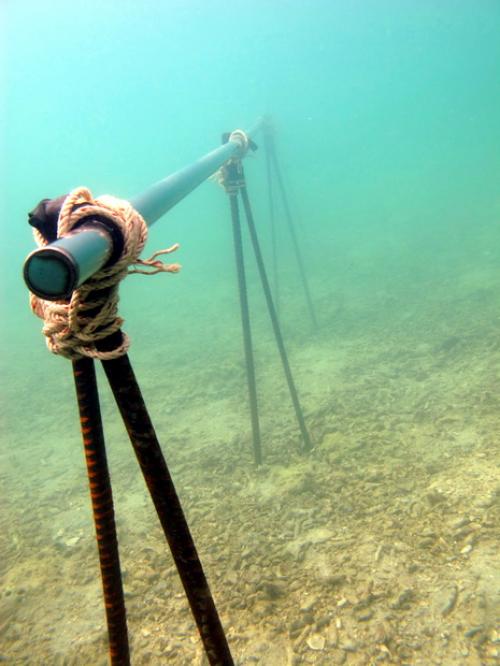Phuket seawalkers deny destroying corals

PHUKET: About 200 square meters of coral have been damaged off Khai Nai island in Phang Nga, say local marine officials, in order to create a pathway for tourists to walk on the sea floor.
The manager of the seawalking company at the site, however, has defended his business, telling the Phuket Gazette it is environmentally friendly and had not damaged any coral.
Seawalking – walking on the sea floor while wearing a helmet supplied with oxygen from a boat above – was banned in local areas from 2007 until the law forbidding it lapsed last year.
Phuket marine officials, after learning of the damaged coral from locals, dived at the site on the east side of Khai Nai island on March 22. The group included staff from the Department of Marine and Coastal Resources (DMCR) and the Phuket Marine Biological Center (PMBC).
“We found that over 200 square meters of medium-quality corals had been destroyed,” said Dr Nalinee Thongtam, senior marine specialist at the PMBC.
“Coral reef had been cut to create a flat walkway,” she said.
Dr Nalinee photographed a metal railing set in the pathway for tourists to hold on to at the now-cleared site.
The cut coral was piled on top of living coral, protected sea clams had been relocated, and the support boat was anchored by rope to coral, said Dr Nalinee, who has detailed illustrations of the site.
“A total area of about 300 square meters of coral was affected, and at least two laws were broken,” she said.
It is illegal to destroy coral and the metal bar and roped coral contravene marine regulations that do not allow fishing areas to be altered, she said.
Dr Nalinee and her colleagues reported the damage to police at Koh Yao Noi island, but were told the police could not take action unless they witnessed the destruction in progress.
About 10 days later, on April 3, Dr Nalinee sent one of her staff to check on the coral. He reported back that it was starting to die, and took photographs of seawalking in progress.
“Some of the damaged coral still has the potential to grow back again with the right treatment,” Dr Nalinee said.
“It is now very important for all governmental organizations to cooperate and fix the damage,” she added.
Dr Nalinee told the Gazette that the case has been reported to her superiors at the PMBC, to the DMCR, to the Phuket Provincial Office of Natural Resources and Environment, and to the governors of both Phuket and Phang Nga.
The Ministry of Natural Resources and Environment Inspector-General has reported the issue to the Chief Executive of that Ministry.
A beleaguered Somporn Teerin, the manager of J&J Marine, the seawalking company at the site, told the Gazette he had received complaints from all sides and asked for the chance to explain himself.
“‘Eco-tourism’ is what we call our seawalking package,” he said.
“No coral was destroyed. The coral that we removed had been dead for three or four years years already. The walkway where we put the metal bars is a natural coral-free water channel,” he said.
Mr Somporn took exception to the claim that 200 square meters of coral had been disrupted.
“The metal bar is only one inch thick and six meters long, so it is irrational to claim that we are the reason the 200 square meters of coral has been destroyed,” he said.
As for the boat being anchored by rope to coral, Mr Somporn said he was told by “experts” that this was safe for coral.
“Corals around the island are being destroyed by divers and anchors from boats. I consulted with specialists who told me that wrapping ropes underneath coral is safe for them,” he said.
Mr Somporn also said he had consulted with local leaders before starting his business.
“This [business] will be beneficial for the locals as well; we will be providing employment for them,” he said.
Mr Somporn said that he is expecting to start the first seawalking tour this week after documents filed with the Tourism Authority of Thailand (TAT) and the Ministry of Natural Resources and Environment have been completed.
When asked by the Gazette about the seawalking already in progress witnessed by Dr Nalinee’s officer, Mr Somporn said he wasn’t sure what was going on. “It must have been a safety drill,” he said.
Press were invited to visit the seawalking site on March 29, along with Dr Korn Sirinam, Parliament’s Adviser to the Committee of Land, Forest and Law Enforcement.
At that time, Mr Somporn said that sea animals would not be interfered with or harmed because experts would set up environmental safety standards and tourists would have to agree to abide by them.
Dr Korn said, “We went seawalking for 30 minutes, and I saw that no harm had been done to the sea ecosystem because the area is small, approximately 10 square meters. There is also a sand walkway for tourists to walk along and observe corals and sea animals,” he said.
“I confirm that seawalking should have no impact on the underwater ecosystem, but I also suggest that the agencies should be strict with the rules and take care of potential long-term consequences. They have to follow legal regulations in every step they take,” he concluded.
Additional reporting by Kritsada Mueanhawong.
— Namsai Wongsaeree
Latest Thailand News
Follow The Thaiger on Google News:


























